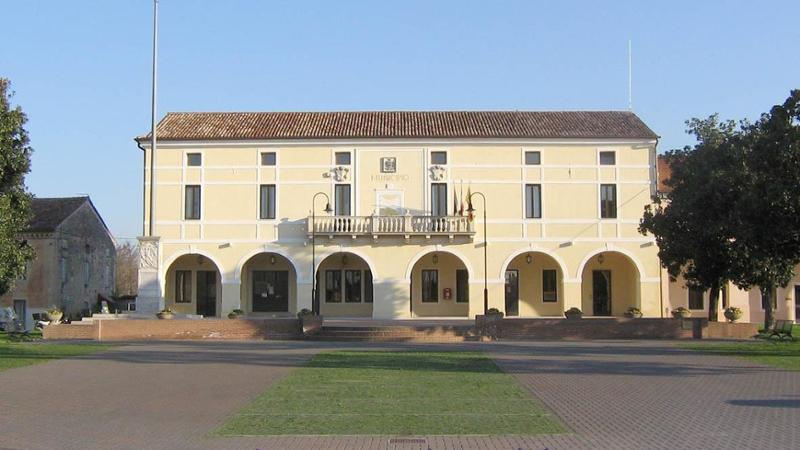
HISTORICAL NOTES The first document that speaks of Gazzo dates back to 1187, when the locality began to be deforested and the bishop of Vicenza Pistore invested Guido Alberti di Montorso with possessions that "lie in the Gazo wood".
In the Middle Ages, the territory was the scene of struggles between Sigismund of Hungary and the Carraras of Venice, then the decentralized position of the town favored it, exempting it from being the passage of armies or the scene of battles. The deforestation work continued, so much so that in the 19th century the landscape had changed completely, becoming almost marshy. At the time of the Union of Veneto to Italy, Gazzo was famous for its rice fields and many were owned by the noble Diedo Venetian family. Most of the houses consisted of thatched roof huts. The conditions of the inhabitants were harsh and precarious: they lived in a flat area with canals and ditches (Ceresone, Riello, Moneghina, Puina, Armedola, Geda), where the scarce crops consisted of rice, fodder, maize, grapes and a sericulture. Perhaps the only resource was cattle breeding.
Gazzo, with Grantorto and Carmignano di Brenta, had belonged to the Province of Vicenza until 1853, when it was aggregated first to Cittadella and shortly after to Padua.
DEMOGRAPHIC SIGNIFICANCE The demographic situation of the Municipality of Gazzo in the last 50 years is rather fluctuating and consequently also reflects the economic development of the territory. The maximum peak of the resident population dates back to 1951 where the inhabitants are 3,839. We will have to wait until the end of 2006 to overcome the number and reach 3,891. From its peak in 1951, the population gradually declined, with a low point in 1971 of 2,892 inhabitants, until the 1980s. Only since then has there been a trend reversal, very slow initially and rather rapid in the last decade, which brings the Municipality of Gazzo today to 4,344 inhabitants over a territorial extension of 22.64 km2. More than 90% of the territory is intact from an agricultural point of view and therefore destined for animal husbandry.
ECONOMIC NOTES The economic development that has taken place in recent decades has transformed the territory with the advent of craft-industrial settlements.
Agriculture, which has marked the history of the Municipality of Gazzo from the 60s until today, has gradually slowed down. Agricultural businesses, currently 120, have gradually decreased, especially in recent years, forcing many of the medium-small ones to close their doors.
From the 1970s to today, in close relationship with the increase in population, there has been a considerable development of all the economic activities present in the area.
The 5th general census of industry and commerce of 1971 shows 118 artisanal and commercial activities, against 94 of the previous census of 1961. The growth is destined to continue in the following years up to 1991 to count as many as 245 local units, most distributed in the manufacturing sector (69), wholesale and retail trade (64) and construction (50).
NATURALISTIC NOTES The territory is characterized by the presence of well-watered meadows which favor a considerable cattle breeding, above all of dairy cows with relative dairies and the area thus differs from the other neighboring areas which are generally cultivated with corn. The "Centro" dairy in Gazzo is currently active.
There are many watercourses that flow in Gazzo; among these we remember the Ceresone which is born in the vicinity of Sandrigo (Vicenza).
In the area to the north-east of the capital there is a resurgence "El fontanon del diavoeo", which however is running out due to the lowering of the water table, due to the continuous consumption of water in the drainage basin of the Brenta river for agricultural and industrial uses and civilians, which have caused the inversion of the exchange relationship between the river and the groundwater: previously the river gave water to the local groundwater, today instead it drains, absorbs, water from the groundwater
ARTISTIC MONUMENTS
The territory of Gazzo is characterized by the presence of numerous ancient villas and palaces.
The two villas in the capital are Villa Forasacco (Via Francesco Baracca 3/A) and Villa Mazzon (Via N. Sauro 5).
In Villalta you can admire the VILLA TACCHI, which has now been renovated and has become a hotel and congress centre.
The Villa was built at the end of the 1600s with late 19th-century pictorial decorations inside, decorated wooden beams and Venetian terrazzo floors.
The main body of the Villa is on two floors and ends with a triangular tympanum; on both sides follow two wings from which the dovecote tower also rises.
In the recently rearranged garden (statues and fountain are recently built) you can see a small lake, a small church, a grove and an ontagnola which is nothing more than an icebox dug into the ground.
Undoubtedly the most prestigious building in Grantortino is VILLA TACCHI (Via Giuseppe Garibaldi 15), a beautiful eighteenth-century villa surrounded by a delightful park with ponds and centuries-old trees. Around it there are several outbuildings where numerous festivals have been held in recent years, such as the one on the occasion of the sowing of rice or the harvest of maranello maize, which are two of the products that characterize the area.
The building is rectangular and in the central body there is a neoclassical loggia with columns with Ionic capitals and above a triangular tympanum decorated with female figures.
On the sides of the loggia, the building continues symmetrically on two floors with windows decorated with tympanums on the ground floor and windows with balustrades with stone columns on the upper floor.
Adjacent to Piazza IV Novembre (with a monument to the fallen of the two wars) is the MUNICIPAL PALACE; recently both the square and the building have been renovated.
VILLA FORASACCO.
It is a 19th century villa located on a large garden. The plan of the building is rectangular on two floors and with an attic; on the ground floor there are three doors that resemble a loggia and always in the main body there are stuccos in the shape of festoons, the same type of decoration can be seen on the lower side wing. It has always been inhabited and is currently undergoing a restoration.
VILLA MAZZON looks like a compact and symmetrical building of the late seventeenth century with a square plan on two floors plus the attic. It is not currently inhabited and inside both the ground floor and the main floor have Venetian terrazzo floors (commonly known as 'Venetian').
The entrance is a vaulted portal with a decorated frame and above this you can see a stone balcony with small columns on top of which you can see a heraldic coat of arms in soft stone.
In Grossa there is the BARCHESSA DI VILLA TRAVERSO (Via Indipendenza 68) which opens with a large arch and secular trees around it.
On the opposite side (not visible from the road) is the Palladian-style façade of the Palazzo and the barchessa with imposing columns supporting Palladian-style wooden trusses.
Inside the house there are still original black marble fireplace, Venetian terrazzo floor, frescoes and decorations.
In Via Chiesa Vecchia there is also the CHURCH OF THE MADONNA DELLE GRAZIE, known as the "OLD CHURCH". The latter is the first church built in Grossa, it seems in 1200 and has always been kept in excellent condition by the members of the parish community.
In Gaianigo, one of the most important historic buildings is the 'Peschiera' (via Vittorio Veneto 19/A): the VILLA FORASACCO is in fact called this way, as it is surrounded by an irrigation ditch in the past full of fish. It seems to date back to the 1400s and a coat of arms on the right side of the portico bears witness to the ownership of the building by the Folco counts.
In this building the barchessa is particularly noteworthy, with its giant plastered brick columns, it is very reminiscent of the barchessa of Villa Traverso even though renovations have been carried out here which have partially altered the original complex.








